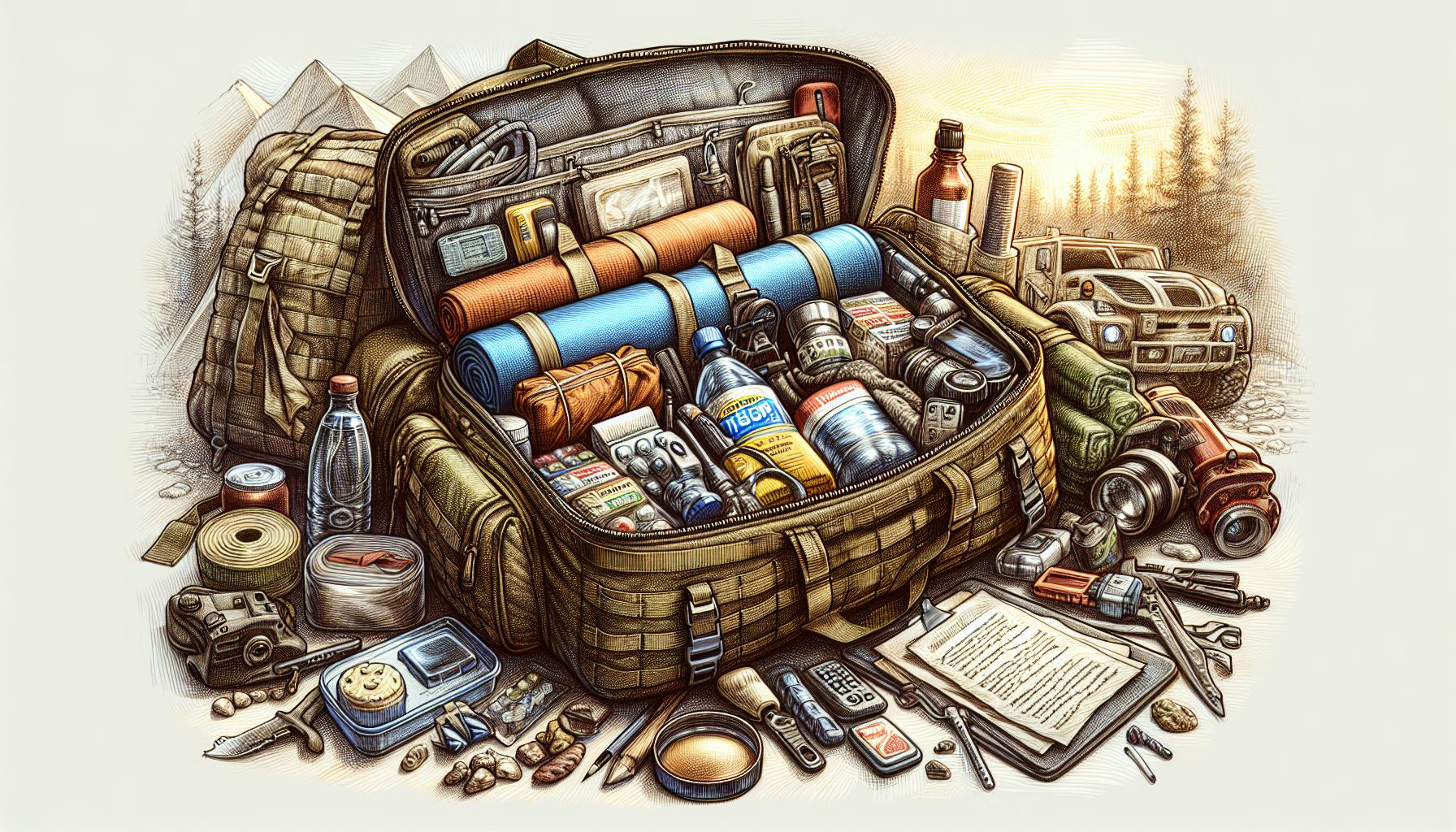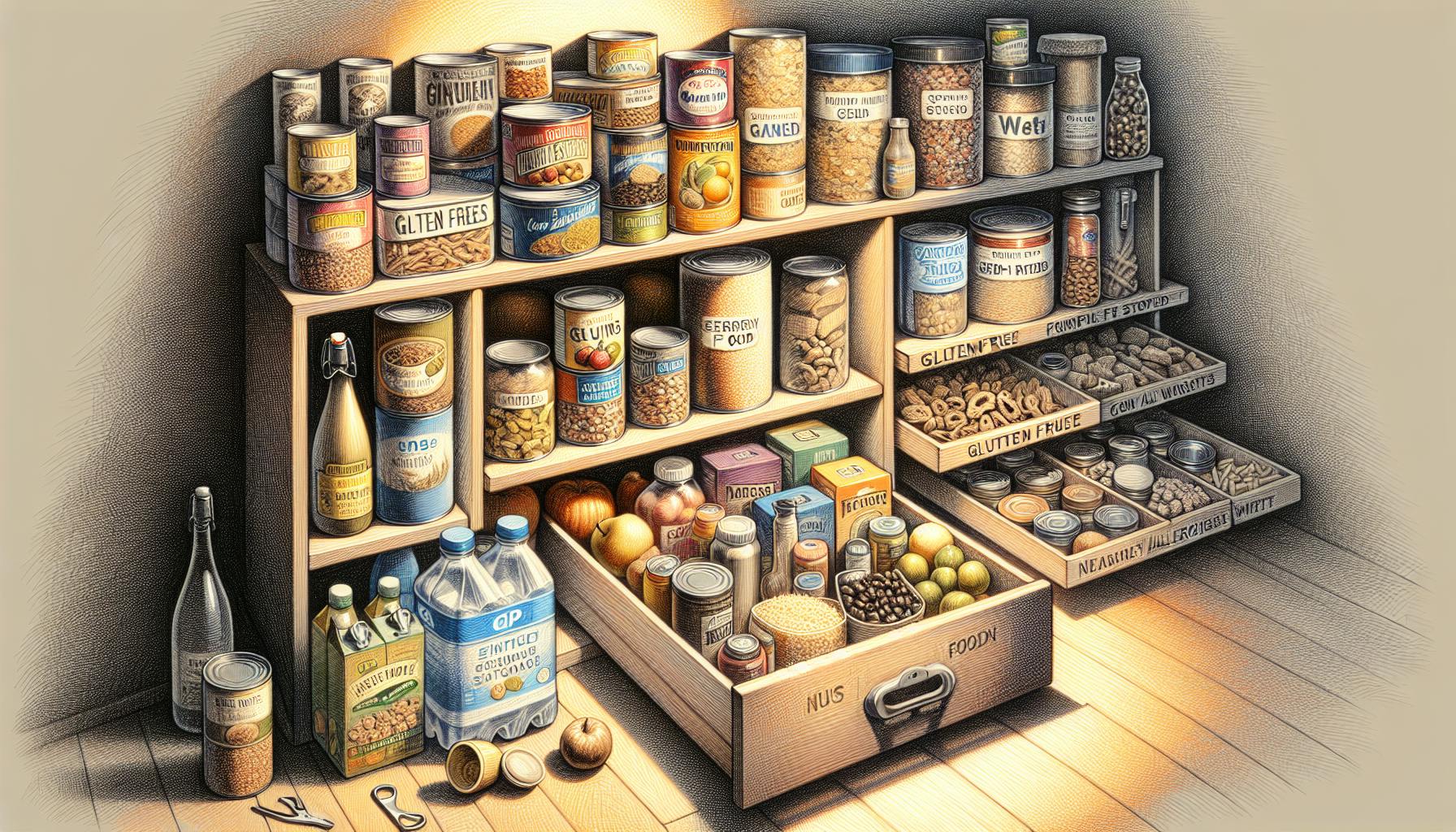When facing an emergency, having the right survival food is crucial for health and safety.
This article will provide guidance on choosing survival meal kits to meet your needs for nutrition, variety, and shelf life.
We'll cover key factors in selecting emergency food, from calorie counts to dietary accommodations, and recommend top survival food brands and kits to consider.
Introduction to Survival Meal Kits
Survival meal kits are prepackaged foods designed to sustain people when access to fresh food is limited during emergencies. They contain nutrient-dense, non-perishable foods with long shelf lives.
Defining Survival Meal Kits
Survival meal kits typically include foods like:
- Canned meats, fruits, vegetables
- Dried fruits, vegetables
- Freeze-dried entrees
- Granola bars
- Powdered milk, eggs, butter
The kits are meant to provide enough calories and nutrients to support an individual or family during short-term or long-term emergency scenarios where normal food supply chains are disrupted.
Who Survival Meal Kits Benefit
Survival meal kits are useful for:
- Preppers focused on emergency preparedness
- People living in regions prone to natural disasters like earthquakes, hurricanes, blizzards
- Anyone wanting to have an emergency food supply ready
The kits allow these groups to have reliable access to food in disastrous situations where fresh food is impossible to obtain.
Key Factors When Selecting Survival Meal Kits
When picking survival meal kits, key factors to consider include:
- Shelf life - longer duration products store better for years
- Dietary needs accommodated - options for various diets
- Calorie levels - sufficient to maintain health
- Number of food varieties - to prevent taste fatigue
Prioritizing these factors will lead to a survival food kit tailored to your situation and needs.
What is the best survival food to buy?
When building your emergency food supply, focus on nutritious, non-perishable foods that meet your dietary needs and will sustain you in an emergency. Here are some of the best options to consider:
Dried and canned goods
Stock up on foods with a long shelf life that are calorie-dense. Some good choices include:
- Dried beans and lentils - High in fiber, protein and nutrients. Look for pinto, black, kidney, garbanzo beans.
- White rice - Easy to store, versatile base for meals. Go for long grain or jasmine rice.
- Pasta - Shelf-stable, packs calories, and easy to cook. Opt for whole grain when possible.
- Canned tuna, salmon, chicken - Good sources of protein to combine with rice, pasta or beans. Get ones packed in water.
- Canned fruits and vegetables - Go for nutrient-dense veggies like spinach, carrots, tomatoes. Choose fruits packed in juice not syrup.
- Whole wheat flour - If you'll do any baking, stock up on flour to make bread, muffins, etc. Store in airtight containers.
- Oats - Steel cut or rolled oats have fiber, protein and nutrients. They keep for 2-4 years stored properly.
Survival food kits
These pre-packaged kits contain a variety of meals or individual ingredients. They're designed for emergencies and have long shelf lives. Consider ones that meet your:
- Calorie needs - Choose kits that provide enough daily calories for those who will rely on them.
- Dietary needs - Seek out gluten-free, diabetic friendly or other special diet kits.
- Taste preferences - Sample kits first if possible to find ones with meals you'll enjoy.
- Budget - Compare costs per meal/calories provided to maximize value.
No matter what survival food you choose, store it properly in a cool, dark place and routinely cycle out items as they near expiration dates. Having a diverse emergency food supply can help see you through tough times.
Does survival food really last 25 years?
Survival food kits designed for long-term storage utilize special preparation methods like freeze-drying and dehydration to dramatically extend shelf life. When stored properly in sealed, protective containers, these foods can remain edible for decades.
Here are some key reasons why properly stored survival food can last so long:
-
Dehydration - By removing water, growth of bacteria, fungi and other microorganisms is prevented. Dehydrated foods can last years or decades if kept dry.
-
Vacuum sealing - Storing food in vacuum sealed pouches protects against oxygen exposure which causes food spoilage. This allows for an extended shelf life.
-
Cool & dry storage - Storing food in a cool, dark, and dry place helps prevent temperature fluctuations and moisture which speed spoilage. Storage at stable room temperatures maximizes shelf life.
-
Quality packaging - Mylar pouches, metal cans and thick plastic containers protect against air, light, insects, rodents, and physical damage from crushing/impacts. This maintains freshness longer.
So with the right preservation and storage methods, most unprepared foods can last 5-10 years. But freeze-dried and dehydrated survival meals stored optimally can remain edible for 25+ years, giving you long-lasting peace of mind.
Why is Costco selling emergency food kits?
Costco offers emergency food kits as part of their disaster preparedness product offerings. These kits provide essential food supplies to help families withstand emergencies and disruptions to normal food access.
Selling these kits aligns with Costco's goal of offering products that provide value and meet customers' needs. As they stated:
"The idea came about making a great starter kit for a family who wanted to prepare for any kind of disaster. This is a great value with shipping included."
However, Costco also recognizes that disaster preparedness is still a niche market. Their 6,200 food supply kit is relatively small compared to some of their other, more robust offerings. This indicates that, while some customers are buying them, demand for emergency food kits is not yet mainstream.
In summary, Costco sells emergency food kits to:
- Meet customer demand for disaster preparedness products
- Provide starter kits at an affordable price point
- Tap into a growing, but still niche preparedness market
The availability of these kits at Costco makes emergency food supplies more accessible to families looking to enhance their readiness. Even though demand is currently limited, their presence can help raise awareness of disaster preparation among shoppers.
How long does Patriot pantry food last?
Patriot Pantry food kits are designed to last up to 25 years when stored properly. Here are some key things to know about the shelf life of these emergency food supplies:
-
The food is freeze-dried and vacuum-sealed in thick plastic pouches that block out moisture and oxygen. This allows the food to remain edible for decades.
-
Proper storage is vital. Kits should be stored in a cool, dry place away from direct sunlight and extreme temperatures. The ideal storage temperature is 60-70° F.
-
Food quality remains high up to the 25 year mark if stored properly. The taste, texture, and nutritional value show minimal degradation over time.
-
After 25 years, the food remains safe to eat but may start to show more noticeable changes in taste, texture, and nutrition. It's still an excellent source of calories and nutrition in an emergency.
So in summary, Patriot Pantry kits offer exceptional shelf life of 25+ years for emergency preparedness. With proper storage, you can depend on these food supplies being there when you need them even decades down the road. The key is keeping them sealed and stored appropriately to maximize freshness over the long haul.
Assessing Caloric Needs for Emergency Scenarios
When preparing for an emergency, properly assessing your family's caloric needs is crucial to ensure you have adequate food supplies. This section provides guidance on estimating daily calorie requirements based on age, health status, and activity level.
Understanding Basic Caloric Needs
As a general guideline, the average caloric needs are:
- Women: ~2,000 calories per day
- Men: ~2,500 calories per day
Children, pregnant women, nursing mothers, and very active individuals need additional calories above these baselines. Seniors and less active people may need fewer calories.
Utilizing Online Caloric Needs Calculators
To estimate your family's exact calorie requirements:
- Use an online calorie calculator
- Input each family member's age, gender, height, weight and activity level
- The calculator will estimate daily calorie needs for each person
Re-calculate as family members' weights fluctuate.
Adjusting Caloric Intake for Emergencies
During an emergency situation, caloric needs often increase due to:
- Physical exertion required for survival tasks
- Exposure to extreme cold or heat
- Elevated stress levels
When packing emergency food rations, allow for 10-25% higher calorie intake per person to account for these factors. Having some high-calorie dense foods like nuts, protein bars and dehydrated meals is also recommended.
Carefully assessing your family's caloric requirements under emergency conditions can ensure you store an adequate emergency food supply.
sbb-itb-b932644
Selecting the Best Survival Meal Kits for Variety and Nutrition
When choosing survival meal kits, it's important to select options that offer adequate variety and nutrition to support your needs in an emergency. Here are some key considerations:
Ensuring a Diverse Range of Food Types
Look for kits with at least 10-15 different entrées or main dishes. Having options like pasta, rice, beans, soups, and more will provide a diverse range of nutrients and flavors. Avoid kits with mostly freeze-dried meats, as you'll miss out on fruits, vegetables, grains, and more for balanced nutrition.
Meeting Dietary Restrictions in Survival Kits
If you or family members require special diets, prioritize companies that accommodate:
- Gluten-free
- Dairy-free
- Vegetarian/vegan
- Kosher
- Halal
- Allergen-free (nut, soy, etc.)
Restricted diets are difficult enough day-to-day. Having appropriate emergency food is crucial.
Choosing Familiar Foods for Comfort
Stress is amplified in disasters, especially for children. Choosing kits with similar comfort foods to what your family normally eats can ease fears. Mac and cheese, mashed potatoes, rolls, and more may help picky eaters adapt.
Focus on taste preferences and familiarity to optimize nutrition. If foods are rejected due to distaste, their nutritional value is irrelevant. Prioritizing acceptance supports physical and mental health in hard times.
Understanding the Shelf Life of Survival Meal Kits
When preparing for an emergency, having a reliable food supply is critical. Survival meal kits are designed to last for years, providing sustenance when access to fresh food is limited. However, these kits vary in terms of shelf life depending on your timeline and budget.
Options for Short-Term Emergency Food Supply
For more immediate emergency preparedness, meal kits with a 5-year shelf life provide adequate calories and nutrients. Popular options like Wise Food Storage buckets or Mountain House pouches are tasty and convenient choices. While suitable for weather disruptions or short-term crises, these short-term survival meal kits require replenishing every few years to stay fresh.
Investing in a 25-Year Emergency Food Supply
25-30 year meal kits allow you to "buy once, store forever." Brands like Valley Food Storage or Emergency Essentials offer freeze-dried ingredients sealed in mylar pouches with decades-long shelf lives. Though more expensive upfront, these long-term survival food options eliminate the need to reorder and can sustain your family through extended disasters.
Creating a Layered Approach to Food Storage
Consider combining short and long-term survival meal kits to balance cost and longevity. For example, keep a 1 month supply of portable Mountain House pouches for evacuation emergencies along with a 25-year Valley Food Storage kit for indefinite sheltering. This diversity protects against disruptions in production of any one product while making preparedness more affordable.
Critical Features of the Best Survival Food Kits
When preparing for emergencies, having survival food kits with adequate nutrition and a long shelf life is essential. As you evaluate different meal kit options, here are some key features to compare:
Comparing Calorie Levels Across Kits
- Calculate your family's daily caloric needs based on age, gender, activity levels.
- Compare kits that offer meal plans aligned to different calorie levels (1,200, 1,800, 2,400 calories per day).
- Prioritize kits lasting at least 2,000 calories per person daily for short-term crises.
Options for Accommodating Special Diets
- Check if companies offer specialty meal plans for paleo, gluten-free, vegetarian and other restricted diets.
- Having variety accommodates individual needs and prevents taste fatigue over long periods.
- Consider adding supplemental foods if kits don't fully meet a special diet.
Assessing Food Taste and Quality
- Research online reviews and testimonials regarding food taste and quality.
- Quality ingredients lead to better nutrition and palatability long-term.
- Balance taste preferences with shelf life when choosing kits.
When selecting survival meal kits for your household, compare across brands on shelf life, tailored calorie levels, variety for special diets, and food quality based on reviews. Prioritizing these features will lead to kits that best sustain your family during emergencies.
Where to Find Survival Meal Kits for Sale
Survival meal kits can be purchased from a variety of retailers to meet your specific needs. When selecting a retailer, consider factors like variety, bulk pricing, and shipping costs.
Survival Meal Kits on Amazon
Amazon offers a wide selection of survival food kits at reasonable prices. You can find kits for individuals or families that are specially formulated to last 25+ years. Amazon Prime shipping provides quick delivery. Easy online ordering and reviews help choose the best options.
Options at Costco and Other Wholesale Retailers
Bulk retailers like Costco allow you to buy larger quantities of survival meals at lower unit prices. While selection is more limited, buying in bulk makes sense for larger families. Wholesale club memberships provide free shipping. You can also find decent emergency food kits at wholesale chains like Sam's Club or BJ's Wholesale Club.
Survival Food Kits for a Family of 5
When shopping for a family, look for food kits that supply 2,000+ calories per day for each family member. Portion out meals appropriately based on age and gender. Prioritize variety, nutritional balance, and longer shelf lives. Mountain House and Wise Foods offer high-quality survival meal options for groups of 5+.
Purchasing survival meal kits from trusted online and wholesale retailers allows you to shop for the best options at reasonable prices. Compare different brands and formulations to find the ideal emergency food supply for your situation.
Top Recommended Survival Meal Kit Providers
When choosing a survival meal kit, it's important to consider shelf life, calorie density, taste, and whether the meals accommodate any dietary restrictions you may have. Here's an overview of some top-rated survival food brands to help you decide which is best for your needs.
Best Survival Meal Kits on the Market
Some of the most popular and highest rated survival meal kits include:
-
Wise Food Storage: Offers gluten-free and vegetarian options with a 25-year shelf life. Meals average 300-400 calories and come in pouches that just need water. Great variety with breakfasts, entrees, fruits, vegetables, and sweets.
-
Mountain House: Known for tasty, quality ingredients and recipes. Food pouches have a 30-year shelf life if unopened. Average 500-800 calories per pouch. Accommodates gluten-free, vegetarian, and kosher diets.
-
Augason Farms: Wide range of bulk ingredients like grains, beans, milk, eggs, and meat in #10 cans with up to 30-year shelf life. Allows you to build customized meals and suits various diets. Average 400-800 calories per serving.
-
Thrive Life: Freeze-dried, gluten-free and non-GMO meals with up to 25-year shelf life. Offer vegetarian, vegan, kosher, dairy-free, soy-free options. Average 300-500 calories per pouch.
When evaluating these top survival food kit brands, consider your household's unique dietary needs and preferences. Also factor in costs, as bulk #10 cans provide more calories per dollar compared to individual pouches.
Comparing Popular Brands and Their Offerings
Here's a detailed comparison of key attributes across top providers of survival meal kits:
| Brand | Shelf Life | Calories/Serving | Taste | Dietary Options | Avg. Cost/Day |
|---|---|---|---|---|---|
| Wise Food Storage | 25 years | 300-400 | Good | Gluten-free, vegetarian | $3-$5 |
| Mountain House | 30 years, unopened | 500-800 | Very good | Gluten-free, vegetarian, kosher | $7-$12 |
| Augason Farms | 30 years | 400-800 | Decent | Customizable ingredients | $3-$5 |
| Thrive Life | 25 years | 300-500 | Very good | Gluten-free, vegan, kosher, dairy-free | $7-$10 |
As you can see, Mountain House and Thrive Life rate higher for taste while still accommodating various diets. Augason Farms provides economical bulk ingredients to create your own customized meals. And Wise Food Storage strikes a balance between taste, variety, shelf life and affordability. Evaluate your household’s unique preferences and needs to decide which brand offers the best survival food kit for you.
Conclusion and Key Takeaways
When selecting survival meal kits for your emergency preparedness plans, there are a few key factors to consider:
Shelf Life
- Focus on kits with a long shelf life of 10+ years. This ensures the food will be edible when you need it, even years into the future.
- Avoid kits with shelf lives under 5 years, as the nutritional value and taste can degrade.
Calories Per Day
- Choose meal kits that provide adequate calories (1,200+ per day) to meet your family's needs in an emergency scenario.
- Pay attention to serving sizes and do the math to determine total calories per kit.
Variety
- Look for a wide variety of entrées, sides, and breakfasts to add diversity and appeal.
- Rotating 10+ entrees helps avoid food fatigue if relying on the kits for extended periods.
Special Diets
- Select kits with gluten-free, vegetarian, and allergen-free options to accommodate special diets.
- Carefully inspect ingredient labels if you have food restrictions.
When prepping for disasters, survival meal kits are a convenient way to stock up on shelf-stable foods tailored to your household's unique needs. Assess each option across shelf life, calories, variety, and diet to determine the best fit.


